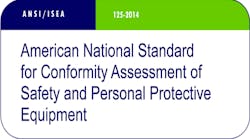To say that American National Standard for Conformity Assessment of Safety and Personal Protective Equipment, ANSI/ISEA 125-2014, is a consensus standard is an understatement. Literally hundreds of comments – 140 pages’ worth at one point – were discussed, incorporated into the standard or discarded (with an explanation).
The process, which took four years from initial discussion to approval by the American National Standards Institute (ANSI), included stakeholders from industry, end users, EHS professionals and a host of others. The process wasn’t quick or easy, admits Dan Shipp, president of the International Safety Equipment Association (ISEA), and Cristine Fargo, ISEA’s director of member and technical services, but it was valuable.
“I always knew that it would happen (publication of the standard), but now that it has, it’s a great feeling,” said Shipp.
Standard Is Four Years in the Making
The first serious discussions among the safety equipment manufacturers who are members of ISEA began occurring in February 2010 at a board meeting. A working group was empaneled to determine if the organization should support the expansion of third-party assessment of personal protective equipment (PPE). OSHA did not require third-party assessment as part of its PPE standards, because the agency believed that voluntary compliance was high among manufacturers.
“That was before the industry was as global as it is now,” said Shipp. “Manufacurers noticed that products were beginning to come in – mostly from Asia – that looked just like their products, even down to the ANSI mark. But when they tested those products, they weren’t coming close to meeting the ANSI standards.”
They began discussing developing a voluntary standard that would provide requirements for product testing, process quality management, market surveillance, corrective action and recordkeeping and a standardized way to inform the purchaser of how the product was evaluated for conformity.
Members of the ISEA Standards Policy and Planning Committee, which developed the standard, were familiar not only with U.S. regulations and the certification process in the United States, but also with European equipment standards and certification processes. Needless to say, the group “went through a number of drafts,” admitted Shipp.
“I ran out of fingers and toes” counting drafts, added Fargo, who managed the process and who jokingly claims to have aged as a result.
Comprehensive Review of the Proposed Standard
Once a draft was ready, it was submitted for a comprehensive, outside, peer review by manufacturers, users, government agencies and safety and health experts globally, as well as for internal review by ISEA members.
Two full consensus reviews later, after reviewing and addressing 142 pages of comments, changes were made and it was sent back out for public review. Once that was completed, it was sent to ANSI for review, which approved it on Feb. 5.
“The information and feedback allowed us to come up with a standard that almost everybody was comfortable with,” said Fargo. “People with differing opinions and mindsets were able to come together to reach consensus.”
NIOSH, which until now offered the only available conformity assessment for PPE (testing and recommending respirators for approval), has been working on a conformity assessment process for a broader range of PPE, said Shipp, adding, “I know the head of the (National Personal Protective Technology Laboratory) lab has a copy (of the ANSI/ISEA standard). With this standard, we’re saying, ‘This is a way you can do it.’”
“The thing this standard does, which is very essential to this marketplace, is provide a uniform way to communicate that you (manufacturer or supplier) are taking these steps to ensure your product meets these requirements,” said Shipp.
Three Methods of Conformity Assessment
The standard establishes three alternative methods of conformity assessment, enabling suppliers, purchasers, customers, regulators and standards writers to match a method with a product or standard where appropriate.
All three methods include requirements for product testing, quality management, market surveillance, corrective action and recordkeeping and a standardized way to inform the purchaser of how the product was evaluated for conformity:
- For Level 1, the supplier tests the product in-house or at a third-party lab.
- For Level 2, the product is tested in a facility that is accredited to international standard ISO 17025, and manufactured under an ISO 9001-registered quality system. Both Level 1 and Level 2 require issuance of a supplier’s declaration of conformity.
- Level 3 of the standard is third-party certification such as UL or SEI, where the entire process from testing to surveillance is under the direction of an accredited certification body, whose mark is applied to conforming products.
Many manufacturers already do these things, said Shipp and Fargo, but ANSI/ISEA 125-2014 formalizes that process and gives purchasers and end users reassurance that products meet certain specifications.
“It’s not necessarily going to change how companies evaluate products if the company already is doing the right thing,” said Shipp, “But they can say, ‘Yes, this is how our process fits into this new standard.’”
Next Steps for ANSI/ISEA 125-2014
OSHA incorporates many voluntary consensus standards, such as ANSI or National Fire Protection Association standards, into its mandated workplace safety standards. A next step for ISEA might be to examine OSHA’s PPE standards to determine where ANSI/ISEA 125-2014 might fit, said Shipp.
Another next step will be education for manufacturers, suppliers, purchasers, EHS professionals and workers.
“We need to inform suppliers and end users and purchasers. We need to educate everybody in the chain how they can use [the standard] to ensure their products are going to protect their workers,” said Shipp.
As part of this educational effort, the ANSI/ISEA 125-2014 standard is available for free on ISEA’s web site. “We want people to understand it,” said Shipp. “We want it widely disseminated and widely understood. We don’t want there to be any barriers to acceptance.”
